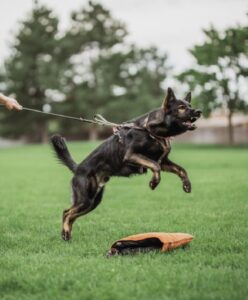In the social media and television age, where highly trained dogs often grace our screens, it’s easy to set lofty expectations for our pets. However, as a breeder, I aim to shed light on the realities of dog training for the average family or individual. This blog will compare professional training on media platforms with what is realistically achievable for families and single professionals, considering time, expertise, lifestyle,
and more.
The Glossy Sheen of Social Media Training
We often see dogs performing remarkable feats on social media and TV, obeying every command with precision. This level of training is usually the result of professional trainers dedicating countless hours and using advanced techniques. It’s important to acknowledge the skill and commitment of these trainers. They often work in environments specifically designed for training, free from the distractions and complexities of a typical home setting.

The Reality for Average Families and Individuals
Time Constraints
For the average family or single professional, time is a precious commodity. Finding consistent time for dog training can be challenging between work, school, and other responsibilities. Unlike professional trainers, who may dedicate several hours daily to training, a family might only manage short sessions a few times a week.
Level of Expertise
Most families and individuals need to possess the level of expertise that professional trainers have. Training methods that work wonders in the hands of a professional might yield different results for a novice. It’s about more than knowing what to do but also how and when to do it.
Diverse Lifestyle Dynamics
Each family or single owner has unique dynamics. A household with children, for instance, presents a different environment compared to a single professional. The presence of young children can mean more distractions and less predictability in training sessions. Single professionals, on the other hand, may have more consistent routines but less overall time at home.
Setting Realistic Training Goals
Families and individuals must set realistic training goals tailored to their specific circumstances. Here are a few considerations:
1. Acknowledge Limitations: Recognize the limits of your time and expertise. Aim for progress, not perfection.
2. Consistency Over Intensity: Short, consistent training sessions are more effective than sporadic, intense ones.
3. Family Involvement: In family settings, involve members in the training process. It helps maintain consistency and gives the dog a cohesive set of commands and expectations.
4. Professional Guidance: Consider occasional sessions with a skilled trainer to get guidance and troubleshoot problems.

Training Tips for Busy Lives
1. Integrate Training into Daily Routines: Use daily activities like feeding or walking as opportunities for training.
2. Focus on Basic Commands: Prioritize basic commands and behaviors that foster a safe and harmonious home environment.
3. Use Positive Reinforcement: This method works well for professional trainers and novices. Reward good behavior to encourage repetition.
Conclusion
While the polished, expertly trained dogs on social media are impressive, it’s essential to have a grounded approach to training in real-life scenarios. Families and single professionals can achieve significant training successes by setting realistic goals, acknowledging their unique lifestyle dynamics, and being consistent in their approach.



